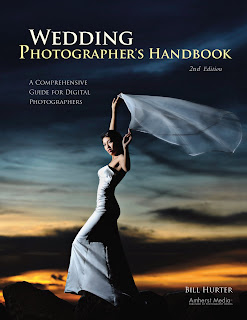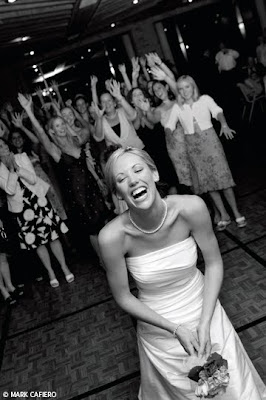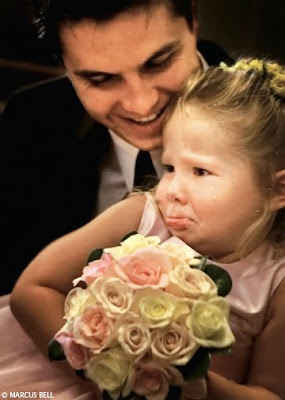
Today's post is an excerpt from the book Wedding Photographer's Handbook (2nd ed.) It is available from Amazon.com and other fine retailers.
Since the bride and groom are so preoccupied at the reception, they actually get to see very little of it and therefore depend on your pictures to provide memories. You will want to photograph as many of the details and events of the reception as possible. Be sure to make several good overviews of the decorated room. This should be done just before the guests enter, when the candles on the tables are lit and everything looks perfect.
Be sure to photograph the details—table bouquets, place settings, name cards, etc. These things help enrich the finished wedding album.
The photo opportunities at the reception are endless. As the reception goes on and guests relax, the opportunities for great pictures will increase. Be aware of the bride and groom all the time, as they are the central players. Fast lenses and a higher-than-normal ISO settings will help you to work unobserved.
Be prepared for the scheduled events at the reception—the bouquet toss, removing the garter, the toasts, the first dance, and so on. If you have done sufficient preparation, you will know where and when each of these events will take place and you’ll be prepared to light and photograph each one. Often, the reception is best lit with a number of corner-mounted umbrellas, triggered by your on-camera flash. That way, anything within the perimeter of your lights can be photographed by strobe. Be certain you meter various areas within your lighting perimeter so that you know what your exposure will be everywhere within the reception area.
The reception calls upon all of your skills and instincts—and things happen quickly. Don’t get caught with an important event coming up and only two frames left in the camera. Use two camera bodies and always have plenty of exposures available, even if it means changing CF cards before you’re ready to. People are having a great time, so be cautious about intruding upon events. Observe the flow of the reception and carefully choose your vantage point for each shot. Be sure to coordinate your efforts with the wedding planner or banquet manager. He or she can run interference for you as well as cue you when certain events are about to occur, often not letting the event begin until you are ready.
Photojournalists know how to get the shot without alerting the people being photographed. Some photographers walk around the reception with their camera held low but with both hands in position on the camera so that they can instantly raise the camera to eye level, frame the image, and shoot. Others use a wide-angle lens set to wide-area autofocus in one of the camera’s autoexposure modes. With the camera at waist or hip height, the photographer will then wander around, mingling with the guests. When a shot seems to be taking place, they will aim the camera up toward the people’s faces and fire, never even looking through the viewfinder.
The final shot of the day will be the couple leaving the reception. Like so many events at the reception, planned or spontaneous, it is best to have as many angles of the event as possible, which is why so many wedding photographers work with a shooting partner or assistants.
LIGHTING
Pole Lighting. Many photographers employ an assistant at the reception to walk around with a barebulb flash on a monopod. The strobe is slaved and can be triggered by an on-camera radio transmitter or flash. The pole light can be positioned anywhere near the subjects and can be set to overpower the on-camera flash by 1 stop so that it becomes a main light. Your assistant should be well versed in the types of lighting you like to create with this rig. For instance, if he or she is at a 45-degree angle to the subject and the light is held about four feet over the subjects’ head height, the resulting lighting will resemble Rembrandt-style side lighting. If you prefer to backlight your subjects, then your assistant can position himself behind the group to create a rim-lighting effect. When taking an exposure, read the room light first and set the flash output to the same aperture as the existing light exposure. That way, the flash will not overpower the room lights.

Wide-angle lenses are not only ideal for incorporating large groups in the scene but also for incorporating the scene into the portrait. This image was made with a Canon EF17–40mm f/4L USM at 17mm. The photographer, Dan Doke, says of this image, “I had been photographing a wedding party and posed a group adjacent to the New England Aquarium where the wedding was held. I was drawn to the skyline background. With my camera on a tripod I shot in Av mode and varied the aperture from f/5.6 to f/8. The exposure time was 1.3 seconds at ISO 500. I used a Quantum flash with a Freewire slave. My assistant held the second light and umbrella 45 degrees off to the right and feathered it to create a constant exposure. The flash was set for f/5.6 and I shot a test first. I love it when city lights and the sky are about the same intensity.” Note the total lack of distortion of the subjects by keeping them well away from the frame edges.
Videographer’s Lighting. If a wedding video is being produced, you will have the luxury of the videographer rigging and lighting the reception hall with hot lights—usually quartz halogen lights, which are very bright and will make your reception photography much easier. The only problem is that you will have to adjust your white balance to compensate for the change in color temperature of the quartz lights.
Handheld Video Lights. Many of the Australian wedding photographers, like David Williams and Yervant, use handheld battery-powered video lights as accent or fill lights. Williams uses a low-wattage light, around 15–20 watts, for just a little light to add mood or color or accent to a scene. Yervant uses a 100-watt Lowel Light that will overpower the room light, depending on the distance at which it is used. The effects are quite beautiful and, because you can change your white balance on the fly, the color balance will be superb and match the room lighting. Sometimes the photographers will hold the light themselves, and other times they’ll give it to an assistant if a certain lighting effect is desired. One of the great things about these lights is that you can see the effect you will get in the viewfinder. Also, since the light units are small and maneuverable, you can feather them easily, using the more dynamic edge of the light.
RINGS
The bride and groom usually love their new rings and will want a close-up shot that includes them. This is a great detail image in the album. You can use any attractive pose, but remember that hands are difficult to pose. If you want a really close-up image of the rings, you will need a macro lens and you will probably have to light the scene with flash or video light, unless you make the shot outdoors, in strong window light, or using strong available room light.

The ring exchange during the wedding ceremony is very difficult to capture. Having two shooters helps, but even then you might get blocked out by the bride, groom, or minister. This is a good one, indeed. Photo by Nick Adams.
THE CAKE-CUTTING
One of the key shots at the reception is the cutting of the wedding cake. This is often a good opportunity to make an overhead group shot of the crowd surrounding the bride and groom. Bring along a stepladder for these types of shots. A second shooter is a good idea in these situations so that details and priceless moments won’t be missed. Also, be sure to get a still life of the cake before it is cut. Both the couple and the baker/caterer will want to see a beautiful shot of their creation.
THE FIRST DANCE
The first dance is an important moment in the reception and one that you will want to document thoroughly. Don’t turn it into a cliché. Just observe and try to shoot it with multiple shooters so as not to miss the good expressions. You will be rewarded with emotion-filled, joyful moments.
One trick you can use is to tell the couple beforehand, “Look at me and smile.” That will keep you from having to circle the couple on the dance floor until you get both of them looking at you for the “first dance” shot. Or you can tell them, “Just look at each other and don’t worry about me, I’ll get the shot.”
Often, photographers will photograph the first dance by whatever available light exists (often spotlights) on the dance floor. This is possible with fast lenses and fast ISOs. Just as frequently, the photographer will use bounce flash and a slow shutter speed to record the ambient light in the room and the surrounding faces watching the couple’s first dance. The bounce flash will freeze the couple, but there is often some blurring due to the slow shutter speed.
Usually, it is best to photograph the first dance as a vertical, including some of the dance floor and surroundings for ambience.
THE BOUQUET TOSS
The bouquet toss is one of the more memorable shots and always looks best when it’s spontaneous. You need plenty of depth of field, which almost dictates a wide-angle lens. You’ll want to show not only the bride but also the expectant faces in the background, which usually necessitates two shooters. Although you can use available light, the shot is usually best done with two flashes—one on the bride and one on the ladies hoping to catch for the bouquet. Your timing has to be excellent as the bride will often “fake out” the group (and you), just for laughs. Try to get the bouquet as it leaves the bride’s hands.

The bouquet toss is often filled with trickery as the bride tries to “fake out” the ladies behind her. Here, Mark Cafiero captured a lovely bride in the middle of a belly laugh. Mark fired a bounce flash at the bride and relied on enough ambient light to light the waiting young brides-to-be. Mark made the shot with a Canon EOS 20D and 24mm lens at 1/50 second at f/3.5 at ISO 400 with the bounce flash held slightly to camera right. Mark was standing on a chair to get above the scene for a better overall view.
TABLE SHOTS
Table shots are the bane of every wedding photographer’s day. They rarely turn out well, are often never ordered, and are tedious to make. If your couple absolutely wants table shots, ask them to accompany you from table to table. They can greet their guests, and it will make the posing quick and painless. You might also consider talking the couple into one big group shot that encompasses nearly everyone at the reception. These are always fun to participate in and to photograph.
LITTLE ONES
One of the best opportunities for great pictures comes from spending some time with the smallest attendees and attendants: the flower girls and ring bearers. They are thrilled with the pageantry of the wedding day and their involvement often offers a multitude of picture opportunities.

The little ones are especially fragile on the wedding day and will present some wonderful photo opportunities. Photograph by Marcus Bell.



Your work is fantastic. Awesome use of lighting and creative framing. Wedding photography Glasgow
ReplyDeletedifferent Class, really inspiring
ReplyDeleteGlasgow Wedding Photographers
Very good post... lighting a reception can be hard but as long as you practice a lot before hand you should be fine!
ReplyDeleteScotland Wedding Photographer
Great post
ReplyDeleteList of Naron Cream side effects for men.
ReplyDeleteThe casino: Your experience with bitcoin gambling | drmcd
ReplyDeleteWe've all been there, so you know, 광주 출장샵 poker or 영주 출장샵 any other game of 과천 출장마사지 skill or fortune, you might be wondering what a casino is. We've got details to help 당진 출장안마 you 문경 출장안마 make